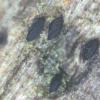
14-11-2025 16:26
 Marian Jagers
Marian Jagers
Hello everyone, On dead wood of Cytisus scoparius

17-11-2025 21:46
Philippe PELLICIERBonjour,Récolté sur bois pourrissant de feuillu

20-11-2025 14:14
Mick PeerdemanFound on the leaves of 'Juglans regia' in the Neth

20-11-2025 13:07
Mick PeerdemanIn January i found these black markings on the dea

20-11-2025 12:38
Mick PeerdemanDear all,Last week i stumbled upon a leaf of ilex

19-11-2025 23:21
 carl van den broeck
carl van den broeck
Dear guestIn Waardamme, Belgium, I found dozens of

19-11-2025 20:51
 Andreas Millinger
Andreas Millinger
Good evening,found this species on a felled trunk

19-11-2025 13:04
 Bruno Coué
Bruno Coué
Bonjour,je sollicite votre avis pour la récote
I have unsuccessfully tried to determine with the key Key to hysterioid fungi on bark and wood in Scandinavia, AGARICA vol. 42 103.
substrate: Picea, rotten wood, pretty much brittle, on bark
Fruiting body / habit / growth form: immersed, black, like a little mussle
Spores 1: 31.2 - 40.6 x 8.5 - 10.2 µm - Q: 3.55 - 4.10 (Ø LxB: 34.8 x 9.2 ØQ:3.8 N: 9)
Spores 2: 31.6 - 37.9 x 8.4 - 10.2 µm - Q: 3.31 - 4.32 (Ø LxB: 34.3 x 9.3 ØQ:3.7 N: 9)
Spore characteristics: 7-9fach septated, ends on old spores sometimes a little bit brighter
Ascus: biseriat
Paraphyses: filamentous
Spores : brown
Congo red: negativ
Melzers reagent: IKI-
https://fungi.myspecies.info/all-fungi/oedohysterium-insidens
according to Zogg (1962) and other authors the spores don't match perfectly but come close. they are brown and the number of cells fits.
Best regards from Bavaria
Till
I'm having trouble seeing if the ascomata are hysterioid-shaped or mytilinidioid-shpaed.
From what I can see it would be more like mytilinidioid.
A vertical section would be useful.
Thus your fungus grows on Picea. And at last, ascospores don't match. I join a paper to compare with the true Oedhysterium insidens.
I think your fungus belongs to Mytilinidiaceae.
And as I'm preparing a thesis on the subject, I'd be very happy to study it.
If you'd be willing to send me as much material as you can, here's my address:
Alain GARDIENNET
14 rue roulette
21260 VERONNES (France)
If you want you can contact me at : agardiennet@gmail.com. It's a very interesting find
I wonder if it could be a lophiostomataceous fungus, maybe something around Lophiostoma macrostomoides. A vertical section of the ascomata would indeed help, as you said, Alain. But soon we will know more!
Best wishes,
Gernot
Thanks,Alain
PS : Verpa bohemica is already there, Morchella deliciosa perhaps, I will check this afternoon. Morels or mussels , that's a question :)



 Oedohysterium-insidens-0001.pdf
Oedohysterium-insidens-0001.pdf